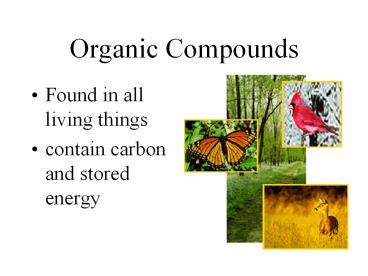Organic Compounds PowerPoint PPT Presentation
1 / 48
Title: Organic Compounds
1
Organic Compounds
- Found in all living things
- contain carbon and stored energy
2
Basic Elements of Life
- Carbon, Hydrogen, Oxygen, Nitrogen (CHON)
compose 96 of living matter
3
What is a macromolecule?
- Macro- big
- Molecule- 2 atoms chemically combined
- A large complex molecule
4
4 macromolecules in all living things
Lipids
Carbohydrates
Nucleic Acids
5
Monomers vs. Polymers
- Mono-one or "part
- Poly- many
- Monomers are building blocks of polymers
6
Carbon UnLimited!
- 4 valence electrons
- Forms 4 covalent bonds
- Tetrahedral bond angle of 1090
7
Carbohydrates
- Contain Carbon, Hydrogen, and Oxygen
- C H O
- 1 2 1 ratio
8
Carbohydrates and Sugars
- Two types of simple sugars
- monosaccharides (1 monomer)
- disaccharides (2 monomers)
9
A. Monosaccharides
- Molecular formula of C6H12O6
- Provide quick energy.
- Only source of energy used by brain.
10
B. Disaccharides
- Two molecules of simple sugar bonded together
- ex. Sucrose (table sugar)
- glucose fructose
- H2O
- sucrose water
11
C. Polysaccharides
- Formed from three or more monosaccharides bonded
together - Four basic types
- starch
- cellulose
- glycogen
- chitin
12
Starch
- Plant food storage
- digestible by humans
13
Cellulose
- Plant structure support wood
- Indigestible, fiber
- Termites digest it!
14
Glycogen
- Animal food/energy storage
- Sugar stored in liver
15
Chitin
- Animal fungi structure
- Forms exoskeleton
16
Lipids (Fats)
- Composed of C, H O
17
Lipids
- Composed of C, H, O
- Not soluble in water (b/c dont form Hydrogen
bonds) - Are soluble in oil
- Fats, steroids, waxes
cheese
butter oils
Bacon grease
18
Triglycerides
- Structure
- 3 molecules of fatty acids attached to one
molecule of glycerol. - Can be fat (solid) or oil (liquid) depending on
temp of environment.
- Function
- Long term energy storage, protect organs,
insulation
19
Types of Triglycerides
Saturated
Unsaturated
20
Saturated Fats
- Saturated--have as many hydrogen atoms bonded to
their carbons as possible (Carbon is saturated
with bonds) - Has ALL C-C single bonds, no double bonds!
- Solid _at_ room temp
21
D
A
C
E
B
22
Unsaturated Fats
- At least one carbon to carbon double bond
- Liquid at room temperature
23
Steroids
- Composed of 4 carbon rings
- Function regulation of metabolism (hormones)
- Examples testosterone, estrogen, growth hormone,
cholesterol-a building block - Artificial prednisone
24
Steroids
25
Phospholipids
- Struct Similar to triglyceride, but one fatty
acid is replaced w/ phosphate group - Function main component of cell membranes,
allows fluids in/out of cell
26
Phospholipids
- A phospholipid has a phosphate head and 2 lipid
tails--in water, the heads point outward,
protecting the tails
27
(No Transcript)
28
Cell Membrane
29
Protein
30
Proteins C,H,O, N
- Monomer of protein amino acid
- Polymers of protein polypeptide protein
31
Proteins
- Meat products, beans, egg whites
- Hair, cartilage
- Structure long chains of subunits called amino
acids - Function structural molecules enzymes, allows
larger particles through cell membrane
32
Amino acids
- There are only about 20 different amino acids in
nature - Our bodies can make 12 of them, the others must
come from food we eat - These are called essential amino acids because it
is essential that they are included in the foods
we eat (since we cant make them)
33
20 Different Amino Acids
- R group of the amino acid makes different
proteins
34
Basic structure of an Amino acid
-)
35
Structure of Proteins
- Protein vocab
- Peptide made of 2 or more a.a.
- Polypeptide composed of 10 or more a.a.
- Protein composed of 100 or more a.a.
36
Structural Proteins
- form body tissue (muscles)
37
This woman has lots of protein hanging from
her head.
38
Hemoglobin
- transports oxygen in blood
39
Antibodies
- defend against foreign substances
40
Enzymes
- Catalyze (speed up) reactions by lowering initial
energy needed for a reaction to occur.
41
Nucleic Acids
42
Nucleic Acids C, H, O, N, P
- Monomer nucleotides
- Polymer nucleic acid, DNA RNA
43
Nucleotides
- Structure
- phosphate group, a sugar, a nitrogen base
- Nitrogen bases Adenine, Thymine, Guanine, and
Cytosine (ATGC)
44
Nucleic Acid Function
- Store and transmit genetic information
45
DNA
- 2 Types of Nucleic Acids
- 1. DNA - Deoxyribonucleic Acid a double strand
of nucleotides with deoxyribose as the sugar
46
RNA
- 2. RNA - Ribonucleic Acid a single strand of
nucleotides with ribose as the sugar
47
Nucleic Acid Function
- DNA--stores genetic information
- RNA--makes proteins
48
Macro-molecule Elements Present Monomer Polymer
Carbohydrate C, H, O monosaccharide Disaccharide, polysaccharide
Lipid C, H, O Fatty acid, glycerol Triglyceride, Steroid, Phospholipid
Protein C, H, O, N Amino Acid Polypeptide
Nucleic Acid C, H, O, N, P Nucleotide DNA/RNA

